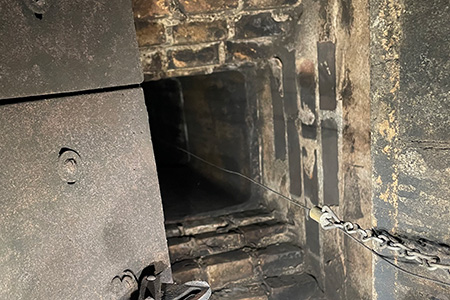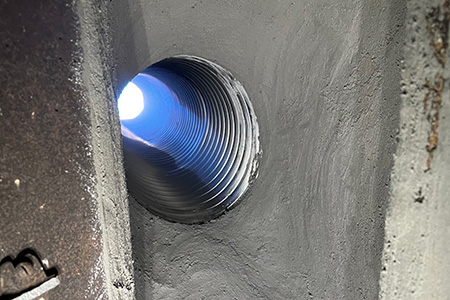Smoke Chamber Repair
Located above the firebox, your smoke chamber is what funnels the smoke and gasses from your fireplace into the lining system of your chimney. Often, these smoke chambers are constructed of brick in a step formation (corbeled) to create the transitional space.
Unfortunately, when the smoke chamber is not parged smooth, it allows the smoke and gasses to cool within the smoke chamber area before it makes its way up the chimney. This causes the bi-products of combustion (creosote) to form on the walls of the smoke chamber and flue system at a greater rate. Creosote, being highly combustible, is the cause of the majority of chimney fires or high heat events we diagnose and reduces the efficiency of your fireplace.
Corbeled smoke chambers may increase the chance of deterioration of the smoke chamber to go unnoticed. Gaps and defects in smoke chamber walls allow heat transfer to surrounding combustibles, producing a greater risk of the fire making its way into your home. When the smoke chamber is parged with the appropriate material, it provides an extra level of insulation and protection to the surrounding combustible material as well.
The NFPA (National Fire Protection Association) recommends that all inner surfaces of the smoke chamber be parged smooth with an insulating refractory mortar. (11.2.1.13)
What To Expect:
Whether being done in correlation to chimney liner repair or independently when the chimney flue condition is up to code and safety standards for use, parging the smoke chamber is a minimally invasive process. Often, our technicians will enter the fireplace/firebox to properly access the interior of your smoke chamber to properly apply the parge-coat. Smoke chambers vary in size - you may be surprised when your technician is able to stand in your fireplace! The technician will then work to apply ChamberSafe to your smoke chamber, smoothing out the surface to allow for a seamless transition for your fireplace to draft.
Scheduling Your Parging Project:
More often than not, parging is performed with the installation of a a new fireplace liner. In this case, it will be completed during that installation process and should be allowed to cure 24-48 hours prior to use. When done independently, a parging project can generally be completed within 2-4 hours depending on the size of your smoke chamber. Once the estimate is agreed upon, we will request a signed copy of the proposal returned to the office, a deposit if necessary, and we will be happy to schedule at your earliest convenience.
 |
 |

